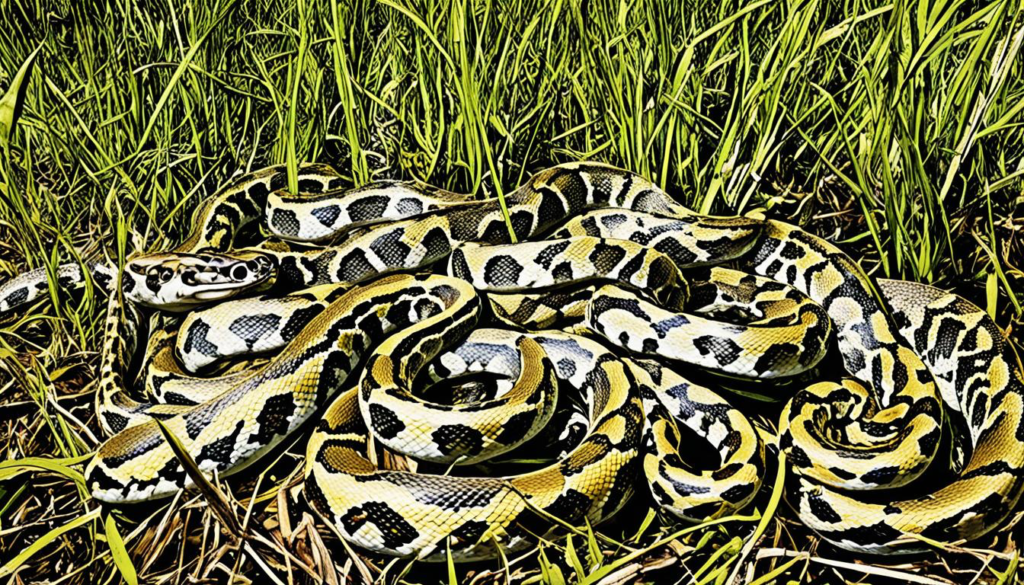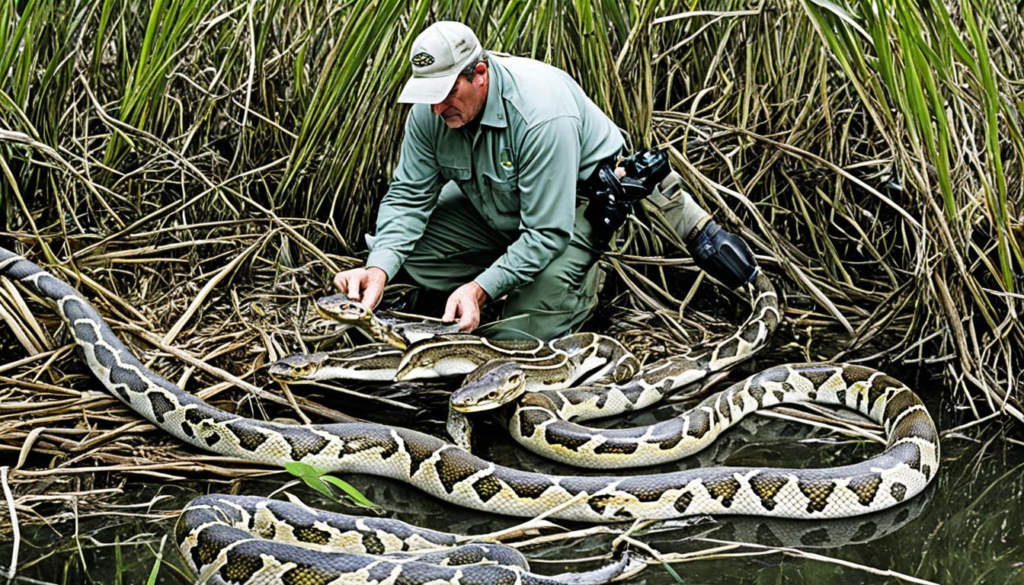The Florida Everglades is under threat. A huge number of Burmese pythons, an invasive species, are now living there. These snakes are harming the park’s wildlife because they have no natural enemies.
These pythons can grow over 20 feet long. They have changed the Everglades’ ecosystem a lot. Female pythons lay up to 100 eggs every year. This makes their numbers grow fast in the area’s marshlands, savannas, and waterways.
Wildlife is suffering severely. For instance, the raccoon population dropped by 99.3% between 1997 and 2012. Opossum numbers also went down by 98.9%. Florida is fighting back with its Python Elimination Program. They have removed nearly 4,000 pythons. However, many thousands are still out there, putting the Everglades’ future at risk.
Introduction to the Invasive Burmese Python
The invasive species in Florida, the Burmese python, has caused major problems in the Everglades and the South Florida area. These snakes came from Southeast Asia and are very good at living in different places. They breed a lot, especially in Miami-Dade, Monroe, and Collier counties, hurting the local animals and plants.
Burmese pythons look unique with their tan skin and dark spots that look like a giraffe’s. These giant snakes can get very long, up to 20 feet, but most are about 8 to 10 feet. They can weigh over 200 pounds and are at the top of the food chain in the Everglades.
These large pythons cause problems not only because of their size. They also eat a lot and have many babies. A female might lay 50-100 eggs, and they can have up to 100 eggs a year. This makes their numbers grow fast and hard to control.
These snakes like to live near water, which the Everglades has plenty of. Their home there is huge, almost as big as Rhode Island. This has caused a big drop in some animal populations, like raccoons and opossums, by about 99%.
Florida is working hard to control these snakes. They have trained over 400 people to help. They also want the public to report snake sightings through a special app or online.
They are trying to make the area less inviting for the pythons. They tell people to not let their exotic pets go free. Instead, they should bring them to Pet Amnesty Day events.
The problem with the Burmese python is huge and costs a lot of money, about $100 billion in the U.S. The situation got worse after Hurricane Andrew because it let many pet pythons escape. Stopping them from spreading needs a lot of work and everyone’s help.
Here are some important facts to know:
| Characteristic | Description |
|---|---|
| Max Length | Up to 20 feet (with the longest recorded in South Florida being 18 feet 8 inches) |
| Color Pattern | Tan with dark “giraffe” blotches |
| Weight | Known to exceed 200 pounds |
| Breeding Populations | Mainly in Miami-Dade, Monroe, and Collier counties |
| Habitat | Wetlands and bodies of water within the Everglades |
Dealing with the invasive Burmese pythons needs many people working together. This includes the community, wildlife experts, and the government. Together, they can help control and hopefully reduce the number of these snakes.
Origins of the Burmese Python in the Everglades
Florida’s Burmese python issue started with the pet trade. They first appeared in the Everglades in 1979. People brought them over in large numbers, charmed by their uniqueness. But soon, these snakes either escaped or were released, leading to big ecological problems in South Florida.
The Everglades now face a big challenge because of these pythons. They have adapted well, reproducing quickly. This situation has made it hard to control their spread in this unique ecosystem.
Intentional Release and Unintended Consequences
The Burmese python problem began with their popularity as exotic pets. Over 99,000 were imported into the U.S. between 1996 and 2006. When they grew too big, many owners let them go. This has negatively affected local wildlife and the environment in southern Florida.
There’s been a big drop in native animal sightings due to the pythons. Raccoon sightings are down by 99.3%, and opossums by 98.9%. Even rabbits have vanished in some places. Female pythons can lay up to 100 eggs a year, making it urgent to manage this issue.
Initial Sightings and Current Distribution
The python issue was first noticed in 1979. By the 1980s, their presence was undeniable. It’s hard for wildlife agencies to control their spread due to multiple introduction points.
Wildlife experts are trying to manage a python population between 30,000 and 150,000. These snakes are known for their size and rapid reproduction. Protecting Florida’s ecosystems from them requires firm policies and actions.
The python invasion highlights several challenges. Their established breeding population in South Florida continues to threaten the area’s ecological health. This battle showcases the conflict between human activity and the need to preserve our ecosystems.
The Burmese Python Everglade Ecosystem Impact
The invasive Burmese python in the Everglades National Park has caused a big drop in native wildlife. This alters the ecosystem’s balance. Dr. Christina Romagosa’s research shows these pythons have a big impact by eating mammals. This badly affects native species numbers.
Looking closer at their eating habits, the Burmese python’s diet is wide. They eat anything from hispid cotton rats to alligators, based on where they are in the Everglades. Research has noted the spread of the lung parasite Raillietiella orientalis by these pythons. This has led to more infections in native snakes, showing the deep impact of invasive Burmese pythons on the ecosystem.
| Statistic | Detail |
|---|---|
| Native Wildlife Population Decline (1997-2012) | Raccoons and opossums saw declines of approx. 99% |
| Python Diet in the Everglades | Mainly mammals, including diverse species based on location |
| Reproductive Capacity | Female pythons can lay up to 100 eggs annually |
| Estimated Python Numbers | Tens of thousands, with a growing population |
| Pythons Removed by Government Incentivized Hunting | Over 6,000 specimens |
After 1992’s hurricane, dozens of pythons were released. They found the Everglades perfect for spreading fast. A single female python can lay up to 100 eggs a year. This shows the big challenge for conservation in the Everglades National Park.
- The Florida government’s program rewarding python hunting has taken over 6,000 pythons out of the area.
- The Swamp Apes, mostly veterans, help fight this ecological problem and find healing, dealing with PTSD.
To fight the growing problem of invasive Burmese pythons, current strategies focus on management and control. They rely on partnerships and scientific research. These efforts aim to protect the Everglades’ native ecological system.
Ecological Ramifications of Python Predation
In south Florida, Burmese pythons have become a real problem. They breed fast and eat many Everglades mammals. The loss of native creatures is huge. This threatens the balance of the entire ecosystem. Experts are worried.
Decline in Small Mammal Populations
The Everglades used to be full of life. But, pythons have caused big drops in raccoon, opossum, and deer numbers. The decline ranges from 85% to 100%. This shows pythons are a big danger to small mammals. Here’s a table with the scary details:
| Mammal Species | Estimated Decline (%) | Observational Period |
|---|---|---|
| Raccoons | 90-100 | 2000s-Present |
| Opossums | 85-95 | 2000s-Present |
| White-Tailed Deer | 88-98 | 2000s-Present |
Effects on Native Birds and Larger Wildlife
Pythons don’t just affect small animals. They also threaten birds and large creatures. They’re changing who lives and who doesn’t in the Everglades. When pythons eat bird eggs, it harms those bird species. This could mess up the whole ecosystem.
But, there’s an odd upside. Turtles are doing better where pythons are common. Because pythons eat animals that prey on turtle nests. This shows nature often has a way to balance things out.
Stopping the python problem is key to saving the Everglades. The University of Arkansas and others are fighting to keep this place wild. They’re looking for ways to handle these snakes and protect the ecosystem.
Efforts to Control the Burmese Python Population
The rising number of invasive Burmese pythons in South Florida is alarming. This issue has led to strong efforts to remove these snakes. These efforts are backed by wildlife conservation goals. Let’s look at some important facts about this situation.
Over 400 people have been taught to catch these snakes through the Python Patrol program. Since 2017, the Python Elimination Program has hired agents to get rid of the pythons. These agents are key to managing the snakes and protecting the wildlife in South Florida.
| Statistic | Detail |
|---|---|
| Year of the First Everglades Python Finding | 1979 |
| Cost of Invasive Species in U.S. (like Burmese python) | $100 billion in damages |
| Responder Training Through Python Patrol | Over 400 trained responders |
| Python Removal Compensation | $10 – $15 per hour for up to 10 hours daily |
| Record Size of Python Removed | 17 feet and 140 pounds in Big Cypress National Preserve |
The fight against the growing python problem includes paying removal agents. They earn based on the pythons’ size and if they find nests. This approach aims to boost the effort to manage the invasive Burmese python. The capture of a massive 17-foot python in Big Cypress highlights this crisis.
- Females lay 50-100 eggs, indicating potential for rapid population expansion
- Average size of removed python ranges between 8 to 10 feet
- Python hatchlings start at approximately 18 inches in length
- Additional incentives include payment for each foot measured above four feet and for verified active nests
- The program limits the number of contracted python removal agents to 50
By offering rewards for capturing pythons, South Florida aims to save its ecosystems. While these snakes seldom attack humans, their effect on nature is significant. The National Park Service and hardworking agents are working together to protect the area’s natural beauty.
Public Engagement and Python Removal Initiatives

Getting people involved in fighting the invasive Burmese python is key for conservation in South Florida. People help by reporting python sightings to the Florida Fish and Wildlife Conservation. This helps track and manage these snakes. Working together, citizens and officials make a strong team against non-native pythons.
The Florida Python Challenge brings everyone together to find and remove pythons. It shows how important it is to get involved. This teamwork helps keep our ecosystems balanced.
Reporting Sightings via Hotlines and Apps
Using the 1-888-IVE-GOT1 hotline or IveGot1.org makes reporting pythons easy. These reports are crucial for quick action. They help protect Florida’s wildlife by stopping the spread of pythons.
The Florida Python Challenge: A Community Effort
The Florida Python Challenge® is now a yearly event. It draws people who want to cut down the number of pythons. The results from past challenges show how much we can do together for conservation.
People’s efforts in these projects really make a difference. Here’s some recent data showing the impact of python removal:
| Event Highlights | 2022 Results |
|---|---|
| Participants | 1,000 from 32 states, Canada, and Latvia |
| Pythons Removed | 231 invasive Burmese pythons |
| Top Individual Removal | Matthew Concepcion (28 Burmese pythons) |
| Longest Python Caught | Dustin Crum (11 feet, 0.24 inches) |
| Total Pythons Removed Since 2000 | Over 17,000 wild Burmese pythons |
| Noteworthy Mention | Chance Dachton (10 Burmese pythons, $2,500 prize) |
| Awareness Objective | Highlight the impact of invasive species on the Everglades |
This table shows the hard work put into controlling the python problem. It proves that when we all help, we can make a big difference for Florida’s environment.
What the Future Holds: Potential Expansion and Risks
Florida’s ecosystems are facing a challenge because of python species. Over 1,200 Burmese pythons have been caught in the Everglades since 2000. Their population keeps growing. This growth could harm the area’s plants and animals in ways we don’t fully understand yet.
Burmese pythons are part of a bigger problem with invasive snakes in Florida. This includes Boa constrictors in the south and African pythons to the west of Miami. These snakes are a big danger to local animals like the Key Largo wood rat. They are especially harmful, experts say.
About a million constrictor snakes have been brought to the U.S. in the last 30 years. They came mainly through the python breeding business and pet trade. Florida has made rules to control this. Snake owners must pay a fee and show they can keep their pets safe.
Finding these snakes early is key to stop their spread. Improved DNA testing has made it easier to find them. This gives hope, like how other invasive species were removed to protect the Channel Islands’ wildlife.
The National Park Service is trying new ways to fight these invasive animals. They’ve started a program to respond quickly when invasive species are found. By looking for python DNA, they’ve found many in Loxahatchee and Miami-Dade county. This shows we might control the problem with the right effort.
We must keep working hard, funding research, and supporting projects to fight these snakes. Only by working together can we protect Florida’s diverse ecosystems. The battle against invasive species like the Burmese python is crucial for this.
Research and Strategies for Managing the Invasive Species

In the Everglades, the Burmese python threatens native species. Invasive species management is key for groups like the US Geological Survey and the University of Florida. They’re researching ways to stop this snake’s spread.
Scientific Studies and Monitoring
Finding Burmese pythons in the wild is hard, says the US Geological Survey. But there are many pythons in the Everglades. The University of Florida uses radio tracking to learn about python movements and where they live.
These studies help us understand pythons better. Scientists are learning what pythons eat, their genetic makeup, and how they’re affected by mercury. This info helps with both research and protecting the environment.
Advancements in Detection and Removal Techniques
GPS is now being used to track pythons, improving on old VHF telemetry. This tech lets researchers collect 15 times more data on python locations every week. The National Academy of Sciences supports these advanced monitoring methods.
Environmental DNA (eDNA) is a new way to find pythons and other large snakes. It’s proving to be helpful. As this technique gets better, it could improve how we manage python populations.
| Method | Advantages | Future Research Directions |
|---|---|---|
| Radio Telemetry | Accurate home range and movement information | Expand tracking beyond Everglades |
| GPS Technology | Increased data collection frequency | Refine spatial distribution models |
| eDNA | Non-invasive environment monitoring | Developing captive trials for population control |
The US Geological Survey and the University of Florida are working together to fight invasive species like the Burmese python. Their joint efforts aim to improve tracking, understand python distribution better, and find new ways to reduce the snake’s impact on Florida’s habitats.
Conclusion
The spread of the Burmese python in the Everglades National Park is a big problem. It’s hard to manage and protect wildlife in South Florida. Efforts to fix this crisis have grown over time.
The first python challenge removed 68 snakes. The 2023 “Florida Python Challenge” saw more than 200 snakes caught. This shows more people are helping fight this issue.
Since 2006, nearly 20,000 Burmese pythons were caught by citizens and professionals. After starting a year-round program in 2017, the number of caught pythons each year jumped to 1,600 to 3,000. Even with these efforts, the US Geological Survey says getting rid of them in South Florida is “likely impossible.”
They breed fast, live in large areas, and there are still tens of thousands hidden. Yet, catching even one python helps the ecosystem. Native species are starting to do better in areas affected by pythons.
The Florida Python Challenge, efforts by groups like the Conservancy of Southwest Florida, and other conservation acts show a strong commitment. They want to save the Everglades’ ecosystem. Completely getting rid of the pythons may not happen. But the ongoing effort to control them shows a determination as strong as the pythons themselves.
FAQ
What is the Burmese python and why is it considered invasive in Florida?
The Burmese python is a big snake from Southeast Asia found in South Florida, especially in the Everglades National Park. It’s called invasive because it harms local ecosystems. It eats native animals and competes with local predators.
How did the Burmese python get to the Everglades?
It came to the Everglades mainly because of the exotic pet trade. Pets were let go or escaped. This led to them breeding in the wild.
What are the ecological impacts of the Burmese python in the Everglades?
The Burmese python harms the Everglades by eating many native species. This includes endangered birds, alligators, and mammals. Their eating habits have caused native animal numbers to drop. This changes the ecosystem’s natural balance.
Are there any efforts to control the Burmese python population in South Florida?
Yes, efforts are being made to lower the number of these snakes. These include eradication programs and public awareness. There’s also the Florida Python Challenge, which helps remove the snakes.
Can the public help with reporting and removing Burmese pythons?
Definitely. People can report python sightings through hotlines and apps like 1-888-IVE-GOT1 or IveGot1.org. They can also join in the Florida Python Challenge to help catch these snakes.
What potential future risks do Burmese pythons pose to Florida’s ecosystems?
Burmese pythons might spread more due to their ability to adapt and climate change. This threatens more wildlife and could harm more ecosystems in South Florida.
How are scientific research and strategies being developed to manage the invasive Burmese python?
Studies on python behavior and the environment are key. The US Geological Survey and the University of Florida are working on this. They’re improving methods to find and manage the python population.
What is the environmental DNA and how does it help in python detection?
Environmental DNA (eDNA) is what animals leave in the environment. It’s found in soil, water, or air. Detecting eDNA helps us know if pythons are in an area without having to see them.
What can happen to Florida’s native species if the Burmese python population isn’t controlled?
If we don’t control the python population, native species will keep declining. Food chains will be upset, and the environment will suffer. This endangers many animals and the area’s biodiversity.
How successful have removal efforts been in reducing the Burmese python population in the Everglades?
Removing the pythons has helped, with thousands caught and taken away. But finding these snakes is hard because they blend in well, and they breed quickly. We need to keep working hard to make a big difference.













